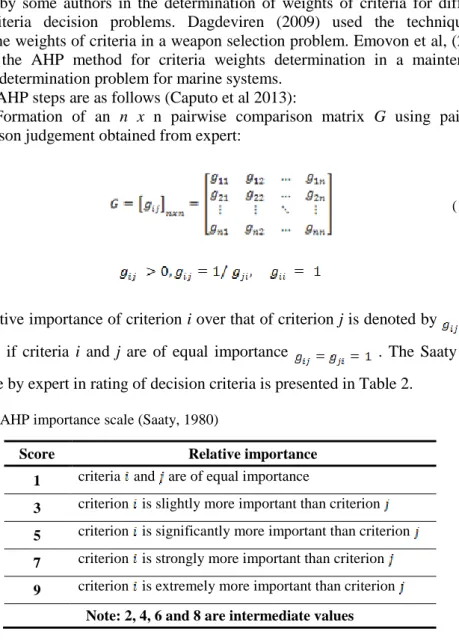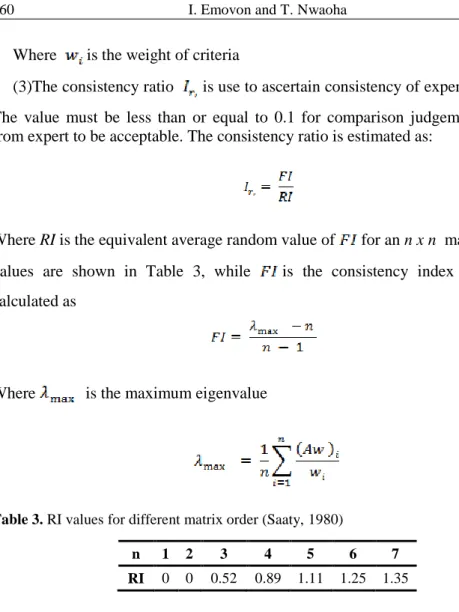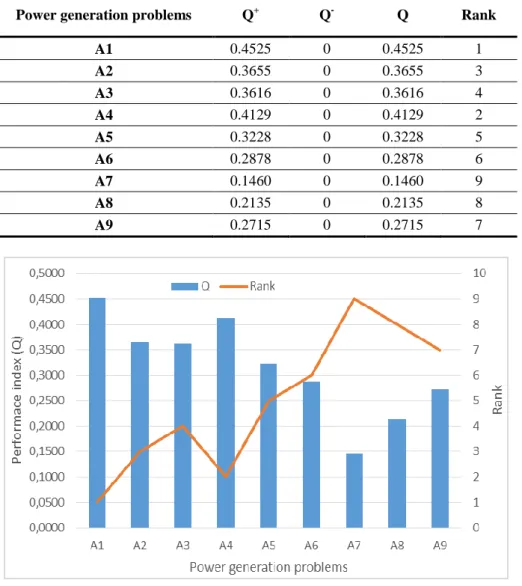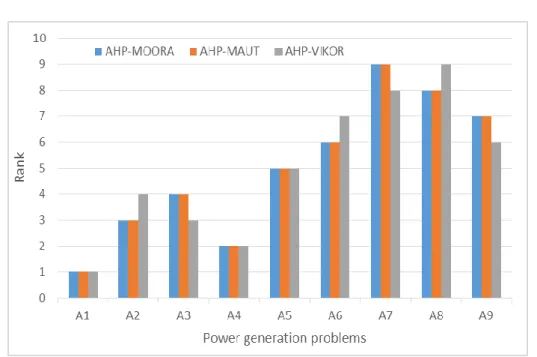POWER GENERATION PROBLEMS RANKING USING
A COMBINATION OF AHP AND MOORA TECHNIQUES
Ikuobase Emovon* and Thaddeus Chidi Nwaoha**
*Department of Mechanical Engineering, Federal University of Petroleum Resources, Effurun, Nigeria, E-mail: emovon.ikuobase@fupre.edu.ng
**Department of Marine Engineering, Federal University of Petroleum Resources, Effurun, Nigeria
Abstract: The inadequate electricity generation in Nigeria is the major reason for her economic woes.
From the literature some of the problems affecting power generation in Nigeria are lack of policy continuity, drought, Militant activities and corruption. However the degree of impact each of the problem has on power generation varies. Therefore there a need to develop a tool that will identify critical problems such that power generation managers’ will use bulk of the meagre available resources in addressing the more critical ones. In this paper a tool which combine Multi-Objective Optimisation on the basis of Ratio Analysis (MOORA) technique with Analytical Hierarchy Process (AHP) is proposed for the prioritisation of the problems affecting power generation in Nigeria. The technique is illustrated with a numerical example developed from data from experts. From the result of the analysis, poor maintenance of power generation infrastructure, militant activities and corruption are the most critical problems hampering power infrastructure development in Nigeria. The proposed technique have been proven to be effective in prioritising power generation challenges as it produces almost completely same result with well-known mathematical techniques in literature.
Paper type: Research Paper Published online: 30 April 2018 Vol. 8, No. 2, pp. 155–168
DOI: 10.21008/j.2083-4950.2018.8.2.3 ISSN 2083-4942 (Print)
ISSN 2083-4950 (Online)
Keywords: Power generation problems, MOORA method, AHP, decision criteria, power
generation infrastructure
1. INTRODUCTION
The key to economic development of developing Countries is having a strong power network that guarantee constant and efficient supply of power to homes and industries. However power supply in developing Countries such as Nigeria is neither constant nor efficient. The inefficient supply of power by the organisations entrusted with the assignment is the major reason for developing Nations economic woes. For example in Nigeria due to erratic power supply most industries have relocated to other countries with more stable electricity and the remaining ones operating and maintaining infrastructure at high cost and the citizens are made to bear the burden of the cost and invariably citizens’ poor standard of living.
Concerted efforts had been made by successive Government in Nigeria with respect to solving power crisis and regrettably none of the effort has yielded positive result with the power generation installed capacity remaining below 25,000 MW whilst the available capacity is below 5,000 MW for an estimated population of about 180,000,000 (Olaoye, 2016). Various reasons have been attributed to the poor power generation and the gap between the installed capacity and the available capacity. Some of the reasons are; poor power infrastructure maintenance, Militant activities, corruption and lack of energy mix. Each of the problem have diverse degree of impact on the level of power generation while some are more critical others are less critical. There is therefore the need to identify those ones that are more critical so that more attention can be given to them in the face of meagre resources available for power infrastructure development in Nigeria.
However, studies carried out on power generation system in Nigeria by most researchers had been mainly on performance assessment, reliability analysis and problems identification. Emovon et al, (2011a) proposed a model for assessment of the performance of Egbin thermal power station, Nigeria. Specifically, the overall model was developed for estimating production losses due to system unavailability. In a similar research Oyedepo et al, (2014) investigated the performance of a gas turbine power plant in Nigeria. Power outage cost resulting from plant downtime was estimated. The study indicated that revenue loss due to system downtime amount to $251 million over the period investigated. Ohajianya et al (2014) discussed factors responsible for unstable electric power supply in Nigeria. The authors identified factors such as inappropriate power reforms and inept workforce. Olaoye et al, (2016) investigated the causes of power crisis in Nigeria and suggested the need to harness renewable energy in order to ameliorate the energy crisis. In a paper authored by Sambo et al (2012) factors such as lack of fund and low private sector participation were identified as the bane of energy
crisis in Nigeria. The authors suggested that privatisation is the key to resolving power sector challenges.
In this paper a tool which combine MOORA method with AHP is presented for prioritising power generation problems in Nigeria. The tool will assist power generation managers in Nigeria to concentrate on the more critical challenges with the meagre resources available for power infrastructure development.
2. POWER GENERATION PROBLEMS IN NIGERIA
The low power generation and the gap between the installed capacity and available capacity are caused by so many factors. Some have high negative impact on power generation while others have less impact. From the literature, see: (Emovon et al, 2011; Sambo et al, 2012; Oricha & Olarinoye, 2012; Oyedepo, 2012; Ohajianya et al, 2014) some of the problems responsible for this obnoxious development are lack of energy mix, poor maintenance of power generation systems, corruption and inadequate fund. The different problems or factors are briefly described as follows:
Poor maintenance (A1): The power infrastructure had been poorly maintained by the bodies’ entrusted with it. They react to failure rather than having a well define maintenance plan for power infrastructure and this had led to near collapse of power system.
Corruption (A2): The meagre resources allocated for power generation infrastructure maintenance and expansion are in most cases mismanage thereby leaving little or nothing for power system development.
Inadequate funding (A3): The budgetary allocation for power infrastructure maintenance and expansions is grossly inadequate for the ever increasing demand for electric power. The consistence increase in the demand is as a result of the geometric increase in human population.
Militant activities (A4): Since most of the power plant in Nigeria are gas fired, pipelines that supply gas to the power plant are deliberately vandalised by militant in the Niger Delta region of the country in response to failure of successive Government with respect to providing basic amenities in the region. The effect is that gas fired plants are shut down until gas supply are restored.
Inadequate or lack of manpower (A5): The technical manpower required for optimal maintenance, operation and expansion of power infrastructure are either grossly inadequate or lacking. As a result, the infrastructure are at the mercy of workforce with little or no ideal of optimising power system for maximum performance.
Wrong location (A6): Due to nepotism and ethnicity most power station are located far from sources of energy and human capacity. This result to extra cost in transporting materials and human resources to power system sites.
Drought (A7): Low rainfall in some seasons have negative impact on the hydropower system production output.
Poor electricity pricing (A8): Most consumers of electricity do not have the financial capacity to pay for the actual cost and thereby forcing Government to subsidise the price which invariably deplete resources for power infrastructure development.
Lack of policy continuity (A9): Most successive Government rather than build on good policies of previous administration, they jettison it and come up with new policies that will eventually be discarded by another Government.
3. DECISION CRITERIA
In prioritising different power generation problems in order to identify the critical ones, decision criteria are needed. For this research the different problems will be ranked based on three decision criteria; environmental pollution (E), critical assets damage (C) and power generation output (P). The decision criteria are briefly discussed in Table 1.
Table 1. Decision criteria
S/N Decision criteria Description
1 Environmental pollution (E) The power problem that will result to greater environmental pollution is the most critical.
2 Critical asset damage (C)
The Power problem that will cause more damages to power infrastructure is the most
critical
3 Power generation output (P) The power problem that will result to lower power generation is the most critical
4. METHODOLOGY
4.1. Analytical Hierarchy Process (AHP)
AHP is a Multi-Criteria Decision Making tool for resolving decision problem involving multiple criteria. The principle basically involves structuring the complex decision problem in a hierarchical form and reducing the problem to a series of pairwise comparisons matrix and then synthesizing the results to obtain
different criteria weights (Emovon, 2016). The AHP was chosen for decision criteria weights evaluation because of its ability to use both qualitative and quantitative data in determining decision criteria weights. Furthermore, it has been applied by some authors in the determination of weights of criteria for different multi-criteria decision problems. Dagdeviren (2009) used the technique to determine weights of criteria in a weapon selection problem. Emovon et al, (2016) applied the AHP method for criteria weights determination in a maintenance interval determination problem for marine systems.
The AHP steps are as follows (Caputo et al 2013):
(1) Formation of an n x n pairwise comparison matrix G using pairwise comparison judgement obtained from expert:
Where
The relative importance of criterion i over that of criterion j is denoted by . For example if criteria i and j are of equal importance . The Saaty AHP scale use by expert in rating of decision criteria is presented in Table 2.
Table 2. AHP importance scale (Saaty, 1980)
(2)Each criterion weight are then estimated as follows:
Score Relative importance
1 criteria and are of equal importance
3 criterion is slightly more important than criterion 5 criterion is significantly more important than criterion 7 criterion is strongly more important than criterion 9 criterion is extremely more important than criterion
Note: 2, 4, 6 and 8 are intermediate values
(1)
Where is the weight of criteria
(3)The consistency ratio is use to ascertain consistency of expert judgement. The value must be less than or equal to 0.1 for comparison judgement obtained from expert to be acceptable. The consistency ratio is estimated as:
Where RI is the equivalent average random value of for an n x n matrix, and the values are shown in Table 3, while is the consistency index and can be calculated as
Where is the maximum eigenvalue
Table 3. RI values for different matrix order (Saaty, 1980)
n 1 2 3 4 5 6 7
RI 0 0 0.52 0.89 1.11 1.25 1.35
4.2. MOORA method
MOORA an acronym for Multi-Objective Optimisation on the basis of Ratio Analysis was developed by Brauers and Zavadskas (2006). The technique have been applied in solving different multi-criteria decision problems. Chakraborty (2011) applied the MOORA technique in real life manufacturing multi-criteria decision problems. Karande and Chakraborty (2012) used the technique in addressing material selection decision problem. Gorener et al (2016) utilised the approach to select optimal bank location site. The method was chosen in this paper because it is easy to understand and implement. Furthermore, it is barely affected by decision criteria weighting techniques nor the normalisation techniques applied unlike most other methods (Karande & Chakraborty, 2012).
(3)
(4)
The steps applicable to the MOORA method are as follows (Yazdani et al, 2016): (1) Formation of the decision matrix. The decision matrix is formed as follows:
(2) The decision matrix normalisation: The normalisation of the decision matrix is as follows:
Where is the normalised matrix.
(3) Evaluation of the weighted normalised matrix is as follows:
(4) Evaluate benefit and cost criteria overall rating for each alternatives as follows.
Where denote index for benefit criteria while denote index for cost criteria. For the benefits and cost criteria the higher and the lower values are desirable respectively.
(5) Determine alternatives overall performance index. The overall performance index for each alternatives is evaluated as follows:
Based on the performance index, Qi, the alternatives are ranked. The higher the value of the index the better the alternative.
(6) (7) (8) (9) (10) (11)
5. RESULTS AND DISCUSSION
As a result of non-availability of quantitative data, qualitative approach was applied. Two expert assigned rating to each of the power problem with respect to three decision criteria using 5-point Likert scale. The two experts rating were averaged to formed a decision Table (matrix) shown in Table 4.
Table 4. MOORA technique decision matrix
Power generation problems E C P
A1 2.5 5.0 5.0 A2 2.0 3.0 5.0 A3 2.5 3.5 4.0 A4 4.0 3.5 4.0 A5 3.0 3.0 3.0 A6 3.0 2.0 3.0 A7 1.0 1.0 2.0 A8 2.0 2.5 1.5 A9 1.5 3.0 3.0
Since decision criteria weights determination is required in the MOORA technique analysis, weights of criteria were evaluated using AHP technique. Applying Eq. 1 to pairwise comparison judgement generated from expert, the AHP decision matrix is formed and is shown in Table 5.
Table 5. AHP decision matrix
E C P
E 1.0 1.0 2.0
C 1.0 1.0 1.0
P 0.5 1.0 1.0
Next Eq. 2 is applied to the decision matrix in Table 5 to estimate the weights of decision criteria and the values of 0.2599, 0.3275 and 0.4126 were obtained for E, C and P respectively. A consistency ratio was evaluated using Eq. 3-5 and a ratio of 0.056 was obtained indicating that the expert comparison judgement is acceptable.
Having obtained weights of decision criteria, the next step is to rank the power generation problems with the MOORA method. Applying the MOORA method,
the decision matrix in Table 4 is normalised using Eq. 7 and the normalised decision matrix is show in Table 6.
Table 6. Normalised decision matrix
Power generation problems E C P
A1 0.0855 0.1748 0.1922 A2 0.0684 0.1049 0.1922 A3 0.0855 0.1224 0.1537 A4 0.1368 0.1224 0.1537 A5 0.1026 0.1049 0.1153 A6 0.1026 0.0699 0.1153 A7 0.0342 0.0350 0.0769 A8 0.0684 0.0874 0.0577 A9 0.0513 0.1049 0.1153
Then the weighted normalised matrix is calculated by applying Eq. 8 and results presented in Table 7. This is followed with the evaluation of benefit (maximum) and cost criteria (minimum) using Eq. 9 and 10 and the results obtained are shown in Table 8. In this paper all the criteria are taken as benefit because of the way the questionnaire were designed and the nature of the decision problem. Hence all the cost criteria values are zeroes. Thereby reducing the MOORA technique to Weighted Sum Method (WSM). The overall performance index is evaluated by applying Eq. 11 and the results are also presented in Table 8 and Figure 1.
Table 7. Weighted normalised decision matrix
Power generation problems E C P
A1 0.0855 0.1748 0.1922 A2 0.0684 0.1049 0.1922 A3 0.0855 0.1224 0.1537 A4 0.1368 0.1224 0.1537 A5 0.1026 0.1049 0.1153 A6 0.1026 0.0699 0.1153 A7 0.0342 0.0350 0.0769 A8 0.0684 0.0874 0.0577 A9 0.0513 0.1049 0.1153
Table 8. MOORA performance index and Rank
Power generation problems Q+ Q- Q Rank
A1 0.4525 0 0.4525 1 A2 0.3655 0 0.3655 3 A3 0.3616 0 0.3616 4 A4 0.4129 0 0.4129 2 A5 0.3228 0 0.3228 5 A6 0.2878 0 0.2878 6 A7 0.1460 0 0.1460 9 A8 0.2135 0 0.2135 8 A9 0.2715 0 0.2715 7
Fig. 1. MOORA performance index and Rank
From Table 8 and Figure 1, the three most critical power generation problems are A1, A4 and A2 having rank first, second and third position respectively while the least critical one is A7 having rank ninth position among the nine alternatives. On the basis of this result, there is the need for the Nigeria Government to channel bulk of it power budgetary allocation in addressing these three most critical power challenges in order to overcome her energy crisis. However the result of the analysis may be influenced by factors such as experts’ opinion, decision criteria,
decision criteria weights and normalisation procedure. When one or more of this factors are modified to suit specific need of the power generation managers/decision makers, the ranking of the alternatives (power generation problems) may change. Nevertheless, the three power generation problems rank as the most critical in this paper had always appeared in almost all articles in literature as main or part of the reasons for energy crisis in Nigeria thereby affirming the validity of the developed technique.
Table 9. AHP-MOORA method in comparison with other mathematical techniques Power
generation problems
Performance index Ranking
AHP-MOORA AHP-MAUT AHP-VIKOR AHP-MOORA AHP-MAUT AHP-VIKOR A1 0.4525 0.8701 0.0124 1 1 1 A2 0.3655 0.6630 0.2147 3 3 4 A3 0.3616 0.6294 0.1608 4 4 3 A4 0.4129 0.7593 0.0682 2 2 2 A5 0.3228 0.5138 0.4145 5 5 5 A6 0.2878 0.4320 0.4819 6 6 7 A7 0.1460 0.0589 0.8984 9 9 8 A8 0.2135 0.2094 0.9072 8 8 9 A9 0.2715 0.3839 0.4946 7 7 6
To further validate the proposed ranking technique, it is compared with two other mathematical methods; Multi-Attribute Utility Theory (MAUT) and Vlsekriterijumska Optimizacija Ikompromisno Resenje, meaning: Multicriteria Optimization and Compromise Solution (VIKOR) and the performance index obtained for each method is presented in Table 9. The ranking of the power generation problems based on these performance indexes are presented in Table 9 and Figure 2. From Table 9 and Figure 2, the AHP-MOORA and the AHP-MAUT methods produces the same ranking of the power generation problems and produces almost the same ranking with the AHP-VIKOR methods. This has further validated the proposed technique; AHP-MOORA.
Fig. 2. AHP-MOORA method in comparison with other mathematical techniques
5. CONCLUSION
This paper presents a technique for ranking power generation problems in Nigeria in order for her to effectively allocate available meagre resource in addressing power challenges. The tool combine MOORA and AHP techniques. While AHP was applied in estimating weights of decision criteria the MOORA method was used to rank the power generation problems. The MOORA technique was chosen for the ranking of alternatives because it is more stable than most other mathematical technique. Furthermore, the tool is simple to understand and implement.
The following conclusion can be drawn from the study.
• The three most critical power generation problems in Nigeria are Poor maintenance (A1), Militant activities (A4) and Corruption (A2).
• The proposed technique produces almost same ranking with other mathematical techniques.
• The MOORA technique is reduced to Weighted Sum Method (WSM) in the absence of cost criteria.
The proposed approach although was design for Nigeria scenario, it can also be used to address other Nations power generation problems prioritisation decision challenge.
REFERENCES
Brauers W.K.M. & Zavadskas E.K. (2006) The MOORA method and its application to privatization in a transition economy. Control and Cybernetics, 35(2), pp. 445-469. Caputo AC, Pelagagge PM, & Salini P. (2013) AHP-based methodology for selecting
safety devices of industrial machinery. Safety Science, 53, pp. 202-218.
Chakraborty S. (2011) Applications of the MOORA method for decision making in manufacturing environment. The International Journal of Advanced Manufacturing Technology, 54 (9-12), pp. 1155-1166.
Dağdeviren M., Yavuz S. & Kılınç N. (2009) Weapon selection using the AHP and TOPSIS methods under fuzzy environment. Expert Systems with Applications, 36(4), pp. 8143-8151.
Emovon I., Adeyeri M.K. & Kareem B. (2011a) Power generation in Nigeria; Problems and solution. In International conference of Nigerian association for energy economics. NAEE, Abuja.
Emovon I., Kareem B. & Adeyeri M.K. (2011b) Performance evaluation of Egbin Thermal Power Station, Nigeria. In Proceedings of the world congress on engineering and computer science California, United States, October 19, pp. 19-21.
Emovon I., Norman R.A. & Murphy A.J. (2016) The development of a model for determining scheduled replacement intervals for marine machinery systems. Proceedings of the Institution of Mechanical Engineers, Part M: Journal of Engineering for the Maritime Environment, e-published ahead of print, Doi: 10.1177/1475090216681345.
Görener A., Dincer H. & Hacioglu U. (2016) Application of multi-objective optimization on the basis of ratio analysis (MOORA) method for bank branch location selection. International Journal of Finance & Banking Studies (2147-4486), (2), pp. 41-52. Karande P. & Chakraborty S. (2012) Application of multi-objective optimization on the
basis of ratio analysis (MOORA) method for materials selection. Materials & Design, 37, pp. 317-324.
Olaoye T., Ajilore T., Akinluwade K., Omole F. & Adetunji A. (2016) Energy Crisis in Nigeria: Need for Renewable Energy mix, American Journal of Electrical Electronics Engineering, (4)1, pp. 1-8.
Ohajianya A.C., Abumere O.E., Owate I.O. & Osarolube E. (2014). Erratic Power Supply in Nigeria: Causes and Solutions. International Journal of Engineering Science Invention, 3(7), pp. 51-55.
Oyedepo S.O. (2012) Energy and sustainable development in Nigeria: the way forward. Energy, Sustainability and Society, 2(1), pp. 1-17.
Oyedepo S.O., Fagbenle R.O., Adefila S.S. & Adavbiele S.A. (2014) Performance evaluation and economic analysis of a gas turbine power plant in Nigeria. Energy Conversion and Management, 79, pp. 431-440.
Oricha J.Y. & Olarinoye G.A. (2012) Analysis of interrelated factors affecting efficiency and stability of power supply in Nigeria. International Journal of Energy Engineering, 2(1), pp. 1-8.
Saaty T.L. (1980) The Analytical Hierarchy Process, New-york: McGraw-Hill.
Sambo A.S., Garba B., Zarma I.H. & Gaji M.M. (2012) Electricity generation and the present challenges in the Nigerian power sector. Journal of Energy and Power Engineering, 6(7), pp. 1050.
Yazdani M., Zavadskas E.K., Ignatius J. & Doval Abad M. (2016) Sensitivity Analysis in MADM Methods: Application of Material Selection. Engineering Economics, 27(4), pp. 382-391.



